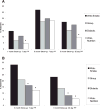Efficacy of an experiential, dissonance-based smoking intervention for college students delivered via the internet
- PMID: 23668667
- PMCID: PMC4640469
- DOI: 10.1037/a0032952
Efficacy of an experiential, dissonance-based smoking intervention for college students delivered via the internet
Abstract
Objective: College represents a window of opportunity to reach the sizeable number of cigarette smokers who are vulnerable to lifelong smoking. The underutilization of typical cessation programs suggests the need for novel and more engaging approaches for reaching college smokers. The aim of the present study was to test the efficacy of a dissonance-enhancing, Web-based experiential intervention for increasing smoking cessation motivation and behavior.
Method: We used a 4-arm, randomized design to examine the efficacy of a Web-based, experiential smoking intervention (Web-Smoke). The control conditions included a didactic smoking intervention (Didactic), a group-based experiential intervention (Group), and a Web-based nutrition experiential intervention (Web-Nutrition). We recruited 341 college smokers. Primary outcomes were motivation to quit, assessed immediately postintervention, and smoking abstinence at 1 and 6 months following the intervention.
Results: As hypothesized, the Web-Smoke intervention was more effective than control groups in increasing motivation to quit. At 6-month follow-up, the Web-Smoke intervention produced higher rates of smoking cessation than the Web-Nutrition control intervention. Daily smoking moderated intervention outcomes. Among daily smokers, the Web-Smoke intervention produced greater abstinence rates than both the Web-Nutrition and Didactic control conditions.
Conclusion: Findings demonstrate the efficacy of a theory-based intervention delivered over the Internet for increasing motivation to quit and smoking abstinence among college smokers. The intervention has potential for translation and implementation as a secondary prevention strategy for college-aged smokers. (PsycINFO Database Record (c) 2013 APA, all rights reserved).
Figures


References
-
- Ames S, Stevens S, Schroeder D, Werch C, Carlson J, Kiros GE, Offord K. Nondaily tobacco use among Black and White college undergraduates: A comparison of nondaily versus daily tobacco users. Addiction Research & Theory. 2009;17:191–204. doi: 10.1080/16066350802318366. - DOI
Publication types
MeSH terms
Grants and funding
LinkOut - more resources
Full Text Sources
Other Literature Sources
Medical
Research Materials

